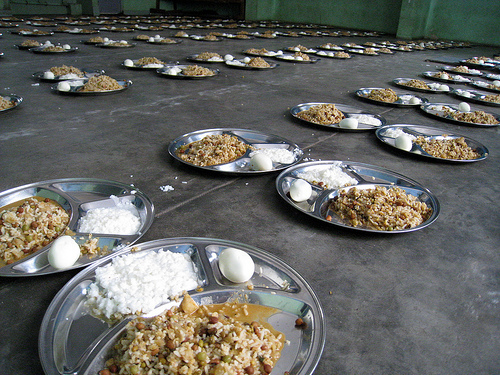Michigan, Kentucky, and Illinois will offer federal-government sponsored free-for-all breakfasts and lunches to students attending participating public schools this fall. Four more states will participate each year until 2014, when all states must allow districts to opt in to a federal program requiring all students at a participating school to eat taxpayer-funded school breakfasts, lunches, and snacks at no cost to any student, regardless of individual students’ ability to bring or pay for their food.
The “community eligibility option,” along with a related provision from the Healthy, Hunger-Free Kids Act (HHK) of 2010, will cost taxpayers an estimated $16 million for the first eleven states, according to the Congressional Budget Office (CBO). The federal government will spend another $100 million for heavier school lunch requirements over the next two years.
The 2010 Act, a centerpiece of First Lady Michelle Obama’s anti-obesity initiative, vastly expands federal school lunch programs and eligibility while increasing food regulations and costs for schools, said David Just, an associate professor specializing in agricultural economics at Cornell University.
“It could be a marginal improvement for the poorest kids, but it’s a pretty big expense for a marginal improvement,” Just said. “Then the things attached, like barring kids from bringing food from home, do impose a cost on parents who may know better than what [schools and the government] are providing.”
Optimizing Taxpayer Costs
Approximately 250,000 school kids are enrolled in the program this fall, in 29 Michigan districts, 36 Illinois districts, and 18 Kentucky districts. To join, a school must provide free breakfasts and lunches to all students and agree to pay program costs above the federal reimbursement, and at least 40 percent of its students must receive state or federal welfare such as food stamps.
Districts opt in only if doing so shifts more expense to the federal government, said Howard Leikert, school nutrition programs supervisor at the Michigan Department of Education. The program pays off for schools where at least 62.5 percent of students already receive taxpayer-paid benefits, he said. States must compare welfare rolls to district enrollment to inform schools and districts of their “community eligibility.”
A main goal of food programs is increasing enrollment. Groups such as the Food Research and Action Program provide manuals instructing districts how to enlist as many students as possible. The law requires states to enroll 95 percent of eligible children—most states didn’t reach 80 percent in 2010—offering financial bonuses for high enrollment and encouraging states to use Medicaid and foster care rolls to identify potential recipients.
“National School Lunch is an entitlement program,” Leikert said. “So if a thousand more kids show up and get fed, the program doesn’t stop, and if a thousand less show up, nobody gets the extra money.”
Increasing Costs and Regulations
HHK also increases nutrition requirements for schools. For example, schools must offer “dark green and orange vegetables” and limit starchy vegetables to one-quarter cup every week, ban 2 percent milk, and make half the grains offered whole-grain. The U.S. Department of Agriculture, which administers federal food assistance, has issued more than a dozen rules on HHK this summer.
Increasing vegetables will improve nutrition, Just said, but the requirements may lead to “strange choices” by kids, such as drinking less milk because they don’t like skim or choosing French fries over peas since both starches are allowed only once a week.
‘Unfunded Mandate’
Though the USDA will shell out an extra six cents per lunch to help with the increased expense, the HHK requirements are “an unfunded mandate of hundreds of millions of dollars that goes into perpetuity,” said Jeannemarie Davis, a senior staffer to Virginia Gov. Robert McDonnell (R). Several governors wrote to complain federal funds for the mandates are “short term and will likely be inadequate to fully cover state costs.”
A USDA analysis found the law will spike the cost of inspecting school food programs 67 percent. Federal administrators plan to raise lunch prices for middle-class and wealthy families to offset these costs.
Detracting from Education
The additional administrative burdens hurts education quality, said David Steiner, New York state’s former commissioner of education.
“Because of federal largess, [NY’s education department] had over 40 experts in school lunches,” he said. “At the same time, we had one expert on science education because the federal funding was there for nutrition experts, but we had to rely on state funding for the science curriculum expert. That wasn’t an intended consequence, but sitting where I did with the staff I had, you can imagine that may feel a little odd.”
Political Incentives to Game Taxpayers
Food welfare is the largest part of the USDA’s budget. Of the $284 billion in CBO-projected costs for the 2008 Farm Bill, $189 billion (about 65 percent) went to such programs. That’s why farm subsidies continue to increase though widely condemned for wasting money, said Vincent Smith, an agricultural economist and professor at Montana State University.
“The agricultural community saw food programs as a way to stimulate demand for food,” Smith said. “USDA was perfectly happy to have the programs launched within USDA to make the agency bigger and more relevant by expanding the constituency.”
Internet Info
“Child Nutrition” letter from state governors, National Governors Association. http://www.nga.org/cms/home/federal-relations/nga-letters/education-early-childhood–workf/col2-content/main-content-list/april-11-2011-letter—child-nut.html
Image by Krupa Asher.





